


PLUS C55 Stereo Preamplifier
Moving coil pre-preamplifier Wideband DC-coupled complementary Class-A circuitry Ultra-low noise and distortion
The new Sanvo PLUS C55 preamplifier strikes an ideal balance between two prevalent classes of audiophile preamps being offered today: the "vestigial preamp, with no operating controls other than an input selector and volume control. and the "knob twiddler's delight", festooned with a confusing and costly array of knobs, switches, and buttons, most of which are seldom if ever used. The C55 is not overburdened with marginally useful controls, yet it can fully satisfy the needs of a very high percentage of the users of sophisticated separate preamplifiers. And for those ultra-critical listeners who view each nonessential circuit and control as a potential source of signal degradation, the C55 is equipped with a single switch that transforms it into a virtual "straight wire with gain.'
An examination of the PLUS C55's front panel will reveal a control center with considerable versatility, but no "frills". In deciding which functions to include. Sanvo engineers followed only one criterion: will the function contribute in a significant way to the quality of the reproduced audio? Thus you will find the mandatory power switch, volume control, and input selector Balance, bass, and treble controls (the latter two with selectable turnover frequencies), plus a stereo/mono mode switch are included to adapt the unit to differing programs and listening conditions. A two-position subsonic filter was provided to address the "real world" problem of warped phonograph records. And finally, a tone defeat switch was added to remove all nonessential processing from the signal path, turning the C55 into what amounts to a "knobless", minimal preamplifier.
CIRCUIT OVERVIEW
As shown in the accompanying block diagram, the circuit layout of the C55 is extremely simple. Audio signals traversing its circuitry pass through a maximum of four, and as little as one "gain block" (the flat amp, which serves to prevent interaction of source and load impedances. to provide needed voltage and current gain, and to guard against the passage of potentially destructive DC offset voltages through the unit, via a single coupling capacitor.) In particular, note that tape dubbing and recording from high level inputs is possible with no active or passive circuitry in the signal path. Also note that the absence of active devices between these inputs and the volume control means that any input signal, no matter how high in level, can be attenuated to prevent
overdriving the flat amp, giving the C55 essentially unlimited line input overload level.
Moving magnet cartridge signals are handled by an FET-input preamp/equalizer which, like all four of the C55's gain blocks, uses fully complementary Class-A output circuitry to reduce distortion to completely unmeasurable levels in many cases. A separate ultra-low noise pre-preamplifier is switched in when the moving coil input is selected.
The differential input stage uses two JFETs (junction Field Effect Transistors), constructed on a single silicon chip to guarantee precise matching, for lower distortion and better bias stability
Both legs of the differential amplifier use special high speed bipolar transistors in a "cascode" configuration. By maintaining constant source-to-drain voltage across the JFET input transistors, the cascode devices eliminate the constant charging and discharging of the internal source-gate

CIRCUIT FEATURES High performance moving coil prepreamp.
The PLUS C55's pre-preamp (or "head amp") uses four bipolar transistors connected in a unique circuit topology guaranteeing high gain and extremely low distortion. The Class-A input stage uses a complementary pair of new, ultra-low noise transistors to reduce input noise to near the theoretical minimum. A second conjugate complementary pair in push-pull common emitter configuration follows, providing additional voltage and current gain. Local negative feedback at each stage combines with global feedback to virtually eliminate both measurable harmonic distortion and the possibility of transient distortion. The MC pre-preamp's 100 ohm input impedance and 100 microvolt sensitivity match any moving coil cartridge while maintaining optimum noise characteristics, and its flat, linear phase response overcomes the disadvantages of MC stepup transformers.
"Discrete op amp" MM phono preamp/equalizer.
The PLUS C55 moving magnet phono preamp/equalizer circuitry was designed with full attention to several recentlydiscovered phenomena affecting disc reproduction.
capacitance with each signal cycle, a process which slows down device response. Thus the cascode pair help the phono section achieve its superb transient and phase response. A matched, integrated pair of "current mirror" transistors form the first stage load, providing increased gain over simple resistive loads. The current mirror drives a high-gain Darlington Class-A stage with constant current source loading, and temperature-compensating diodes for the complementary Class A emitter follower output stage.
Feedback is DC coupled from the output through a precision RIAA equalization network back to the input stage, where the differential configuration and the extremely high input impedance of the FETs totally eliminate the possibility of interaction between the RIAA network and the phono cartridge output impedance (a phenomenon that causes large frequency response errors in many less sophisticated preamps).
Other circuit features include high voltage bipolar power supplies to provide an impressive 250mV overload margin at 1 kHz, an input RFI filter using special high-Q capacitors to prevent radio frequency signals from intermodulating with the
program or causing slewing distortion, and a factory adjusted offset-nulling potentiometer to eliminate DC voltage imbalance, which can cause serious problems in a high-gain preamplifier circuit.

Differential tone and "flat" amplifier blocks.
Much like the phono circuit, the gain blocks for the line amplifier and the tone control amplifier utilize discrete operational amplifier design with DC-coupled Class-A circuitry throughout. The line ("flat") amp even includes the same differential FET cascode input stage with current mirror loading and precision-nulled DC offset as the phono stage. This unusually sophisticated design for a stage regarded as relatively non-critical by many preamp designers helps account for the superior sound of the PLUS C55.
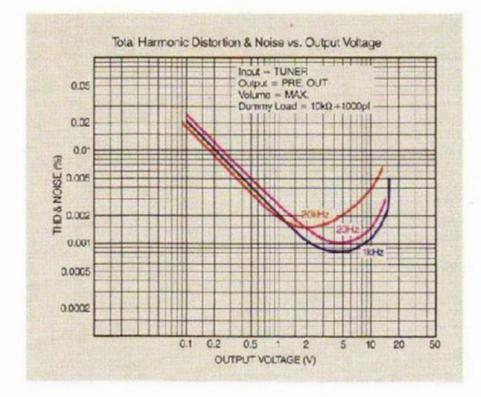
High voltage bipolar power supplies.
The C55's signal circuits are powered by a split DC supply delivering ±27 volts, regulated with great precision by a sophisticated six transistor, zenerreferenced power supply regulator (compared with simple one or two transistor regulators in most preamps). The
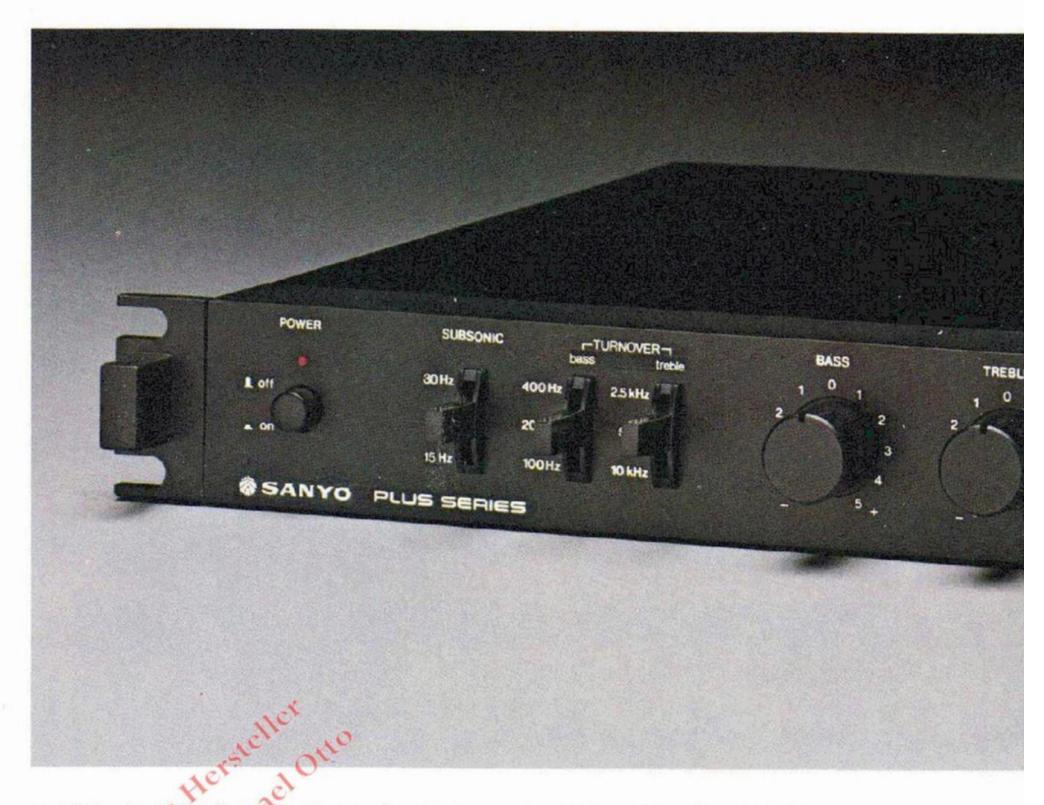
regulator is of the "tracking" type, in which the negative supply voltage is "slaved" to the positive voltage, so that it always remains exactly equal in magnitude. This keeps the signal circuits balanced even during turnon and turnoff cycles, and insures that any instantaneous signalcaused drop in either half of the supply cannot cause an unbalancing shift in the C55's ground potential, which would generate spurious transients at the output and possibly upset the biasing of the entire DC-coupled circuit.
A delayed-action output relay in the C55 protects the power amplifier from turnon transients — not from the C55 itself (there are none), but from signal sources connected to it.
CONTROL FEATURES Passive volume and balance controls and filters.
The PLUS C55's rotary balance and volume controls have no associated active circuitry, insuring that there will be absolutely no signal degradation due to them. Similarly, the 12dB/octave subsonic filter is entirely passive in design to eliminate distortion. Its cutoff point is switchable to 15Hz for most applications, or to 30Hz for severe cases of record warp, acoustic feedback, disc cutter rumble, or
other subsonic noise problems.
Triple turnover tone controls.
Introduced by Sanyo several years ago on stereo receivers, triple turnover points for bass and treble controls have proven to be extremely versatile in their ability to compensate for a wide variety of

equalization tasks. Both the bass and treble controls offer a selection of three turnover points, spaced an octave apart (see curves). The 400Hz and 2.5kHz frequencies provide control action similar to conventional fixed-turnover bass and treble controls. The 100Hz and 10kHz positions affect only the extremes of the audio spectrum, and are ideal for "touching

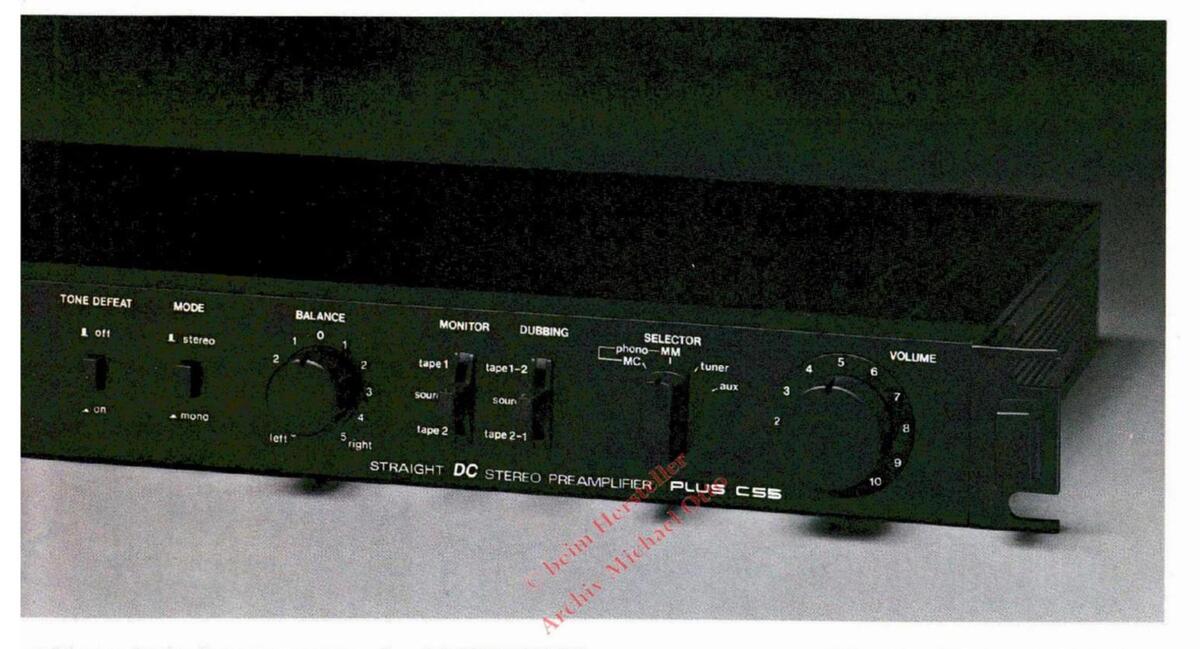
up" the sagging low frequency response of many speakers, the slightly overbright sound of some phono cartridges, and other common audio problems. The 200Hz and 5kHz positions provide an intermediate response which is useful for some situations.
Rather than provide a single, arbitrary "loudness compensation" curve, Sanyo felt that most truly critical listeners would prefer to make their own custom equalization adjustments, using the unusually versatile tone controls.
Complete dubbing flexibility.
The tape enthusiast will find the C55's tape monitoring and dubbing facilities considerably more versatile and logical than those of most audio controllers. A three position lever switch selects the signal to be reproduced by the system power amplifier. Regardless of the status of tape dubbing, you can choose to listen to the currently selected Source (phono, aux, etc.), tape deck 1, or tape deck 2. Actuating the dubbing switch crosscouples the inputs and outputs of the two tape decks, and when used with the monitor switch, permits listening to the original tape, the duplicated tape, or to a different, unrelated disc, radio broadcast, or other signal while dubbing proceeds.
CONSTRUCTION
The mechanical construction of the PLUS C55 is as innovative as its electronics. A single circuit board contains all signal-processing electronics, switches and controls — carefully shielded from both external magnetic interference and the unit's internal AC power supply components. The C55 conforms to EIA standard equipment rack dimensions, occupying a single 1¾" X 19" space, with the supplied rack mounting handles attached.
Two construction details of the C55 deserve special mention:
Mechanical "bridge" switches.
When a C55 switching function requires more than one pole per channel, and when the different switch elements should be in different circuit board locations for optimum noise performance, Sanyo uses steel ribbons encased in flexible "bridges" to transmit switch lever motion from one

section to the other. These special switches eliminate long low-level signal runs which could pick up interference.
Gold-plated input/output connectors.
All 18 of the C55's RCA-type inputoutput jacks are plated with corrosion-
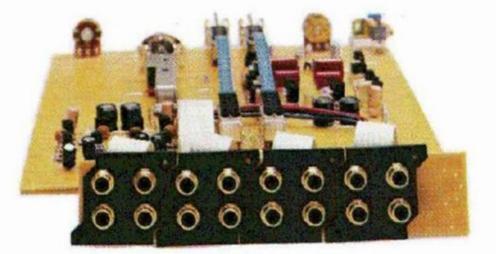
proof gold — seemingly an extravagance, perhaps, but the only way of insuring against the formation of oxides which can actually cause partial rectification of lowlevel signals, creating distortion and serving as a "diode detector" for certain types of radio frequency interference.
Like all PLUS SERIES components, the C55 promises a uniquely satisfying experience to the music lover who is sensitive to the fine points of audio reproduction.
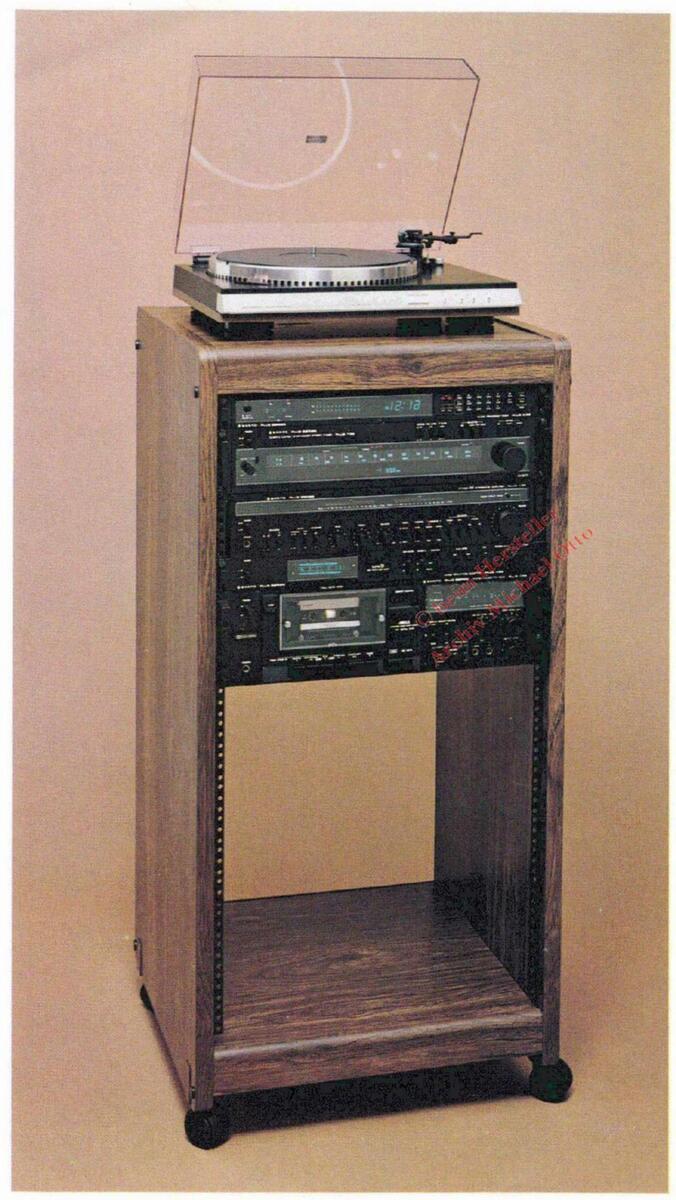
Sanyo's new PLUS SERIES includes a variety of components in professional black finish, with rackmount capability. Handles (supplied with each unit) attach to the chassis sides, and permit secure mounting in ElA-standard 19 inch equipment racks.

PLUS SERIES philosophy
Sanyo PLUS SERIES™— a new collection of ultra-high performance audio components designed, literally from the ground up, to excel in every way: outstanding specifications, useful "human-engineered" controls, features combining the best of traditional functions with unique new solutions, and styling of enduring beauty — plus , most importantly, audio reproduction quality that transcends simple formulas and numerical specifications.
This distinguished new series is the result of a unique design and production concept. Within one of the world's largest and most diversified electronics companies we set up an independent team of audiophile-engineers and gave them full freedom to draw on Sanyo's massive technological capability. A major part of their assignment was to devote special attention to eliminating those small but audible departures from sonic reality - problems that seldom show up on spec sheets or test benches, yet can make the difference between sound that is merely good, and sound that communicates a spine-tingling sense of life, openness, and "air."
To support the PLUS SERIES group, Sanyo produces virtually every part required by their designs: transistors, capacitors, integrated circuits (both analog and digital), circuit boards, motors, meters, frames, knobs, cabinets to name only a few. We control our quality to tolerances far stricter than outside suppliers can match. We back up our production systems with 30 years of know-how from
our consumer and industrial electronics divisions.
Computerized component evaluation with automatic printout of test results.

The development of the Sanyo PLUS SERIES was one of the most difficult goals we have ever set for ourselves: to produce true "state of the art" audio components embodying the enlightened aesthetic and technological perspectives of the 1980's, and to make them available at a cost only slightly greater than the best of today's mass-produced audio equipment.
Our success — or failure — in achieving this almost superhuman goal can be evaluated now by arranging an audition with a PLUS SERIES dealer.
SPECIFICATIONS
| Input Sensitivity/Impedance | |
|---|---|
| Phono (MM) | 2.5 mV/47 k-ohms |
| Phono (MC) | 100 µV/100 ohms |
| Aux, Tape 1, 2 | 150 mV/47 k-ohms |
| Frequency Response | |
| Phono (RIAA standard curve) | ±0.2 dB |
| Aux, Tape | ±0.3 dB |
| (20 Hz - 20 kHz) | |
| ±0.5 dB | |
| (10 Hz - 40 kHz) | |
| Signal-to-Noise Ratio (IHF-A weighted) | |
| Phono MM (at 10 mV) | 97 dB |
| (at 2.5 mV) | 85 dB |
| MC (at 250 µV) | 70 dB |
| (at 100 µV) | 70 dB |
| Aux, Tape | 100 dB |
| Phono Maximum Input Capacity | |
| (1 kHz) MM | 250 mV RMS |
| MC | 10 mV RMS |
| Tone Controls | |
| Bass (100 Hz) | ±10 dB max. |
| Treble (10 kHz) | ±10 dB max. |
| Bass Turnover Frequencies | 100/200/400 Hz |
| Treble Turnover Frequencies | 2.5/5.0/10 kHz |
| Subsonic Filter | |
| Cutoff Frequency | 15/30 Hz |
| Slope | -12 dB/cctave |
| Output Voltage/Impedance | |
| Pre Out | 1 V/600 ohms |
| Tape Out | 150 mV/see text |
| Total Harmonic Distortion | |
| (20 Hz-20 kHz, any input to any output, | |
| output level 3V or less) | 0.003% |
| Power Supply | 120V AC, 60 Hz |
| Dimensions (W x D x H) |
17¼" x 10½" x 1¾"
(19" W with rack handles) |






